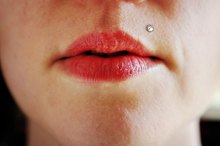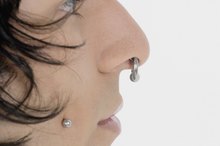Side Effects of Piercings
If you have your piercing performed by a professional body piercer, your chances of contracting a blood-borne disease, such as hepatitis C, are minimal. Even though your piercer uses sterile equipment and jewelry, issues with your piercing may arise. Following your piercer's instructions on how to clean your piercing will alleviate any potential problems with healing.
Beware of Scarring
When you receive a piercing, no matter the location on your body, you will have a scar that remains once you remove the jewelry and allow the piercing to close. If your piercer uses a needle of a correct gauge and the appropriate jewelry for your anatomy, the scarring will be minimal. Piercings performed at large gauge, such as 10 or eight gauge, will have larger scars than traditional piercings, which are usually pierced at 14 or 12 gauge. Keloids, a type of scar tissue that grows around and outside of your piercing wound, are possible if you are prone to keloids.
- When you receive a piercing, no matter the location on your body, you will have a scar that remains once you remove the jewelry and allow the piercing to close.
Irritation Issues
Nipple Piercing Problems
Learn More
Irritated skin inside and outside of the piercing is a normal side effect of the procedure. Depending on the length of the healing period for your specific piercing, your immune system and aftercare regimen, your piercing may feel irritated for a minimum of four weeks to one year. When the piercing site experiences irritation, your piercing will appear swollen and red, and exude a clear, white or light-yellow fluid, according to the Association of Professional Piercers. Your piercing may also itch and be tender to the touch. Washing your piercing daily and avoiding harsh products on your piercing can lessen irritation. Changing the jewelry in your piercing too early during the healing period may irritate the piercing site.
- Irritated skin inside and outside of the piercing is a normal side effect of the procedure.
- Changing the jewelry in your piercing too early during the healing period may irritate the piercing site.
Piercing Infections
Infection is possible in any body piercing. Bacterial infections or allergic reactions are common if you do not take care of the piercing and do not follow your piercer's instructions, suggests Elayne Angel, author of "The Piercing Bible: The Definitive Guide to Safe Body Piercing." Inserting inappropriate jewelry into your new piercing may also cause an allergic reaction 1. Bacteria from your hands, if you are constantly touching your piercing, can lead to an infection in your piercing. Oral piercings are susceptible to infection when coming into to contact with another person's bodily fluids. Professional piercers suggest that you avoid deep kissing and oral sex during the healing period for oral piercings to prevent infection.
- Infection is possible in any body piercing.
- Bacterial infections or allergic reactions are common if you do not take care of the piercing and do not follow your piercer's instructions, suggests Elayne Angel, author of "The Piercing Bible: The Definitive Guide to Safe Body Piercing."
Bleeding Complications
Do Nose Piercings Leave Scars?
Learn More
After piercing your skin, bleeding around the piercing site is common. Some piercings, such as the male genital piercing known as a prince albert, may bleed for several days after the piercing procedure. Your piercing may bleed if it experiences a rip or tear from snagging on clothing, during sports or roughhousing or from pulling on the piercing. If you experience a rip or tear in your body piercing, visit your professional piercer. Continue to clean the piercing while the rip or tear heals and remove any excess dried blood from your jewelry.
- After piercing your skin, bleeding around the piercing site is common.
- Continue to clean the piercing while the rip or tear heals and remove any excess dried blood from your jewelry.
Related Articles
References
- "The Piercing Bible: The Definitive Guide to Safe Body Piercing" ; Elayne Angel
- National Conference of State Legislatures. Tattooing and body piercing | state laws, statutes and regulations. March 13, 2019.
- American Academy of Pediatrics. HealthyChildren.org. Body piercings, teens & potential health risks: AAP report explained. Updated September 18, 2017.
- Johns Hopkins All Children’s Hospital. Adolescent tattoos, body piercings and body modifications. November 21, 2017.
- Koenig, L. M., & Carnes, M. (1999). Body Piercing: Medical Concerns with Cutting-Edge Fashion. Journal of General Internal Medicine, 14(6), 379–385.
- Palo Alto Medical Foundation, Body Piercing
Writer Bio
Maude Coffey retired after 10 years working as a professional body modification artist in the tattoo industry. She is certified in principles of infection control and blood-borne pathogens. Coffey received additional training and classes, such as anatomy, jewelry standards and aftercare, from the Association of Professional Piercers. Coffey aims to educate about safe tattooing and piercing practices while writing for various websites.









